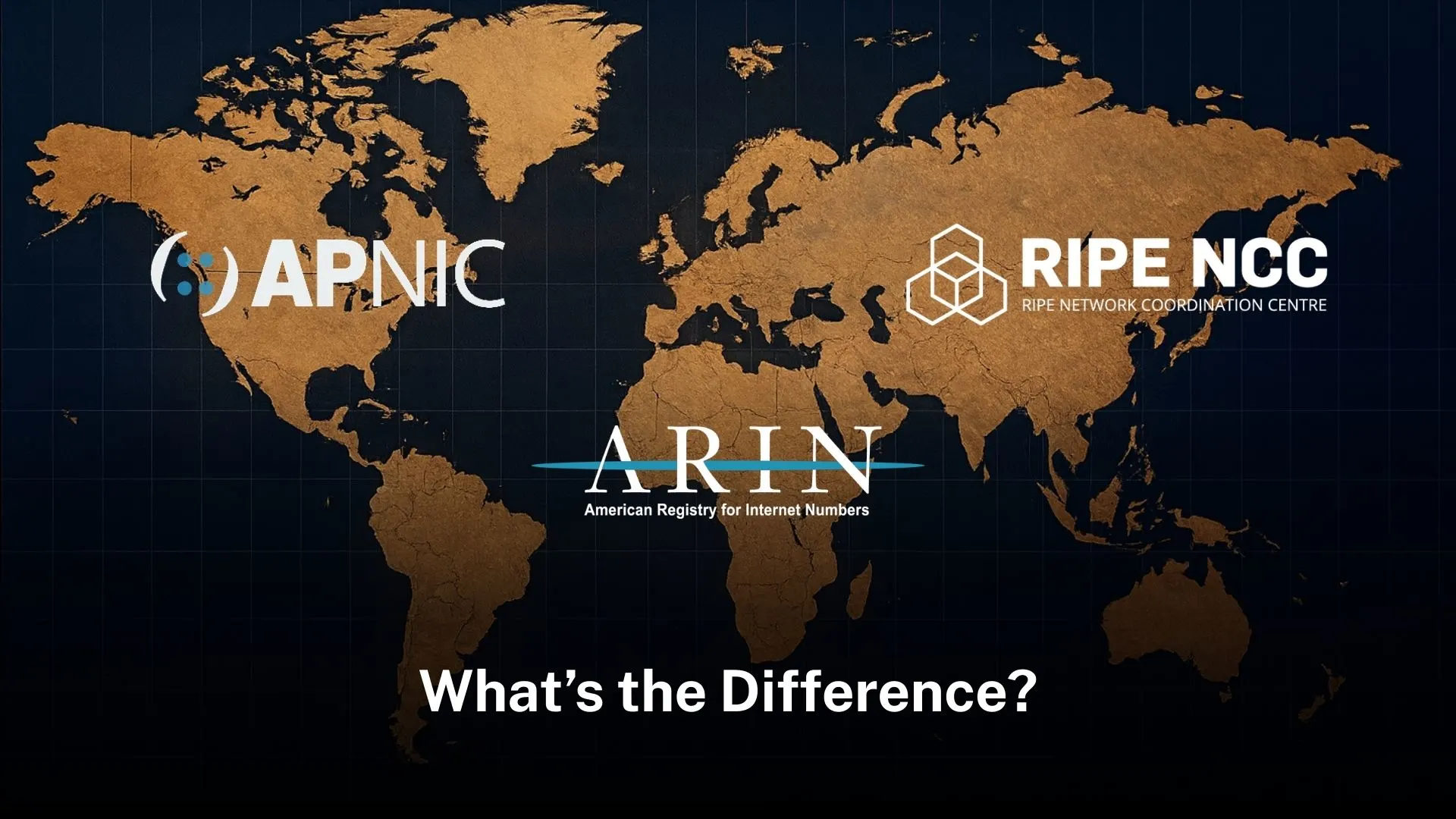This study looks at the differences between three major Regional Internet Registries (RIRs) APNIC ARIN and RIPE NCC which handle the global distribution of Internet Protocol (IP) addresses.
Each of these three RIRs manages IP address allocation in specific parts of the world and they operate with their own unique policies organizational setups and service packages that directly affect internet governance and network connectivity at both regional and global scales.
Introduction
The area of internet infrastructure often seems like a complex system with many organizations working behind the scenes to make sure users around the world have non-stop stable internet access. Among these groups Regional Internet Registries (RIRs) are a key set that get the important job of managing and allocating internet resources with the main resource being IP addresses all within fixed geographic areas.
APNIC ARIN and RIPE NCC are most well-known RIRs, each working in a different part of the world to carry out similar functions while having clear differences in their regional policies governance methods and main focus areas. This study breaks down the specific distinctions between APNIC ARIN and RIPE NCC and explains why understanding these differences is important for businesses network engineers and people who care about global internet governance.
What Are RIRs?
RIRs are specialized groups that have the main duty of managing IP address spaces within their own regional borders and giving IP addresses to various groups including internet service providers (ISPs) data centers companies and other groups that need them.
Besides allocating IP addresses RIRs have other key duties like overseeing reverse DNS services and creating and keeping up policies for internet number resources with a major type being Autonomous System Numbers (ASNs). In short RIRs help keep order in the internet’s infrastructure to make sure IP addresses are distributed fairly and efficiently and that the distribution supports innovation and helps internet-related industries grow. Without RIRs the global allocation of IP addresses would become chaotic leading to fights over address use communication problems between networks and waste of limited IP resources.
What Is APNIC?
The Asia Pacific Network Information Centre (APNIC) is the RIR set to serve the Asia-Pacific area which includes big countries like China Japan India and Australia and it was set up in 1993 to have the main job of giving IP addresses to network operators in its service area. APNIC also takes on tasks linked to the growth and development of the internet in the Asia-Pacific area by offering training programs for network experts relevant technical resources to support regional internet growth and help with community-led processes for making policies.
APNIC’s process for allocating IP addresses starts with strict checks to see if applicants are eligible requiring groups to be legal entities registered in the Asia-Pacific area or plan to use the addresses for networks in this area and to hand in key documents like proof of official business registration records of existing internet resources and detailed network plans that explain how they will use the requested addresses. APNIC uses a tiered system with National Internet Registries (NIRs) for many economies where each NIR has an “allocation window” setting the biggest address space it can give out without APNIC checking further so for requests within this window the NIR sends a request to APNIC with basic registration details including a unique identifier for the recipient gets the allocation directly and passes it to its members while requests over the window need a “second opinion” from APNIC with full reasons for the bigger allocation.
For IPv4 the smallest allocation APNIC gives is a /24 which equals 256 addresses and new members can get up to a /23 (512 addresses) at first with groups needing more than a /23 having to use the IPv4 transfer system that lets transfers happen between APNIC account holders NIRs or other RIRs with matching policies and APNIC even offers a listing service to connect people who have addresses to transfer with those who need them.
For IPv6 allocations are usually a /48 or /32 depending on network size and important infrastructure like root DNS servers or country code top-level domain (ccTLD) operators can get portable IPv4 assignments starting at a /24 though members do not own any allocations and APNIC takes back addresses if membership ends. Lee Howard a network specialist at Juniper Networks says “APNIC plays a key part in helping the internet develop in the Asia-Pacific area and making sure different countries in the area have fair access to IP resources with its wide service range it not only helps allocate IP resources but also leads talks on important issues linked to internet governance especially in emerging markets in the Asia-Pacific area.”
What Is ARIN?
The American Registry for Internet Numbers (ARIN) is the RIR that serves the North American area including the United States Canada and parts of the Caribbean and it was founded in 1997 to be in charge of managing the distribution of IP addresses in these areas while serving many members like commercial businesses schools and government groups working in North America.
ARIN has a unique place in the global internet infrastructure system as a key RIR in North America that takes part deeply in discussions focusing on policies and governance issues linked to IP address allocation.
ARIN’s allocation process is based on a “justification-based” model used most for bigger requests where groups start by making an account in ARIN’s online portal and sending in a request that details their network needs. For IPv4 smaller allocations may need basic proof covering current and expected device counts while bigger blocks need detailed network structure plans and proof of unavoidable address use and providers of important infrastructure like public exchange points or ICANN-approved root DNS operators qualify for “micro-allocations” up to a /24 for IPv4 or /48 for IPv6 with multiple allocations allowed in special cases.
IPv6 allocations follow similar rules with more flexible sizes to encourage use and groups can ask for bigger IPv6 blocks by showing their long-term network growth plans as ARIN puts priority on deploying IPv6 to deal with IPv4 shortage. ARIN also runs a strong transfer market for IPv4 addresses where groups can get extra space from those who no longer need it and all transfers need ARIN’s approval to follow policies that stop hoarding and ensure addresses are used for active networks making this transfer system more and more important as North America’s IPv4 pool gets smaller.
This high level of involvement is especially relevant in North America which has well-developed internet networks and focuses a lot on technological innovation in the internet field. ARIN’s duties go beyond basic IP address allocation to include hard work on advocacy and taking part in creating internet resource policies as it works to reach specific goals for North America’s internet infrastructure like security efficiency and future readiness to adapt to technological changes. ARIN has been an active supporter of using IPv6 the next-generation internet protocol seen as a solution to IPv4 address space shortage.
Cynthia Ferguson a senior policy advisor at ICANN notes “ARIN has played a key part in promoting IPv6 use in North America to make sure businesses and government groups in the area can keep working on technological innovation by stopping limits from lack of available IP addresses and its influence is big because the United States is home to some of the world’s biggest technology companies that rely on ARIN for help with important internet infrastructure.”
What Is RIPE NCC?
The Réseaux IP Européens Network Coordination Centre (RIPE NCC) is the RIR in charge of the European Middle Eastern and Central Asian areas and it was set up in 1992 to play a key part in keeping Europe’s internet infrastructure strong and well-coordinated. RIPE NCC’s mission is to support internet development in its service areas by carrying out activities like allocating and managing IP addresses and ASNs and offering network-related services across all its service areas.
RIPE NCC’s IP address allocation process starts with a “needs assessment” step where all applicants first fill out a network questionnaire collecting info about current network size and future expansion plans. For IPv4 RIPE NCC has a minimum allocation unit of a /24 and applicants need to show they will use at least 80% of the requested address block within 12 months to stop waste of scarce IPv4 resources. For IPv6 the standard first allocation is a /48 for end-user groups and internet service providers (ISPs) can apply for a bigger /32 allocation by proving they have enough end-user customers to justify it.
RIPE NCC also uses an “LIR-centric” model with LIR standing for Local Internet Registry where most allocations are given out through LIRs (usually ISPs or network service providers in the area) that first get a “parent allocation” from RIPE NCC and then give out smaller address blocks to their own customers. RIPE NCC requires LIRs to keep detailed records of all sub-allocations including customer name network purpose and usage status to help track resource utilization across the area. For IPv4 transfers RIPE NCC has a clear policy that the transfer must be between two groups in its service area or one with a presence there and needs approval from RIPE NCC’s resource management team to follow regional policies.
RIPE NCC takes an active part in promoting internet security and creating internet resource policies by organizing training programs and holding events designed to help stakeholders in its service areas work together. A notable feature of RIPE NCC’s operations is its open policy-making process that lets community members take active part in policy-related discussions and help create the organization’s policies.
RIPE NCC serves more than 20000 members including internet service providers telecom companies big businesses and government bodies in its service areas and Europe is a major center for key internet-related groups like data centers cloud service providers and those working on advanced internet technologies making RIPE NCC essential for keeping the internet infrastructure in its service areas stable and functional. Janne Smedlund an internet policy researcher at the Oxford Internet Institute says “RIPE NCC’s open policy-making way is a great model for other RIRs as letting the community take part in shaping policies makes sure members’ needs are met while encouraging innovation and improving security in its service areas.”
Key Differences
ARIN’s work focuses on the North American area. This area includes the United States and Canada. RIPE NCC is in charge of covering three regions. These three regions are Europe, the Middle East, and Central Asia.
In the area of policy development, APNIC, ARIN, and RIPE NCC each use different models. These models are built based on the specific needs of their own regions. APNIC’s policies are shaped by various challenges. These challenges exist in the Asia-Pacific area. ARIN often takes a leading position. Its leading position is in promoting the use of IPv6. This effort is to meet the needs of North America’s internet infrastructure. North America’s internet infrastructure is highly developed. RIPE NCC has a policy-making process. This process is widely known for two key traits. The first trait is openness.
The second trait is its reliance on decisions made by the community. This process also has a focus on inclusivity, making sure different voices are considered.
In community engagement APNIC puts strong focus on training and outreach especially in emerging markets in its service area ARIN has a large well-established community that supports the US tech sector’s interests and RIPE NCC has a well-developed community-driven policy framework that ensures decisions are made through group effort.
In IP address allocation processes APNIC uses a tiered system with NIRs and has strict eligibility checks and clear IPv4 transfer rules ARIN uses a justification-based model and prioritizes IPv6 adoption while running a strong IPv4 transfer market and RIPE NCC uses an LIR-centric model that requires needs assessments and close tracking of sub-allocation records. These process differences are designed to fit each region’s unique traits like the Asia-Pacific area’s diverse economies and emerging markets North America’s mature tech industries and high internet use and Europe the Middle East and Central Asia’s large number of ISPs and data centers.
Why Understanding These Differences Matters
For people working in fields linked to internet governance network management or cybersecurity understanding the three RIRs’ roles is essential because the differences between APNIC ARIN and RIPE NCC affect how groups around the world get and use IP resources and the policies these RIRs create can have a big impact on internet infrastructure security innovation and growth in their respective regions.
For businesses working across multiple regions understanding these differences helps them plan IP resource allocation more effectively and follow local policies set by each RIR. For network engineers knowing how each RIR operates helps them fix IP address management issues more efficiently and ensure smooth network connectivity across different regions. For those interested in internet governance these differences show how regional needs shape global internet operations and the importance of local management in keeping the global internet stable.
FAQs
What is the role of an RIR?
An RIR manages IP address distribution in a specific geographic area, they make sure fair allocation and promote efficient use of internet resources.
Why we have different RIRs?
Different RIRs meet the specific needs of different regions around the world and deal with their unique regulatory environments.
How can businesses work with RIRs?
Businesses can sign up with RIRs to get IP addresses ASNs and other key network resources and take part in the policy-making processes run by RIRs.
Can an organization sign up with more than one RIR?
Yes but most organizations usually sign up with the RIR serving their main region and may sign up with multiple RIRs if they operate across different regions.
How do RIRs help with internet security?
RIRs work to keep the internet’s resource allocation system intact by putting security measures in place and creating policies to protect network infrastructure from misuse which helps stop unauthorized IP address use and lower the risk of network attacks linked to IP resource misuse.




